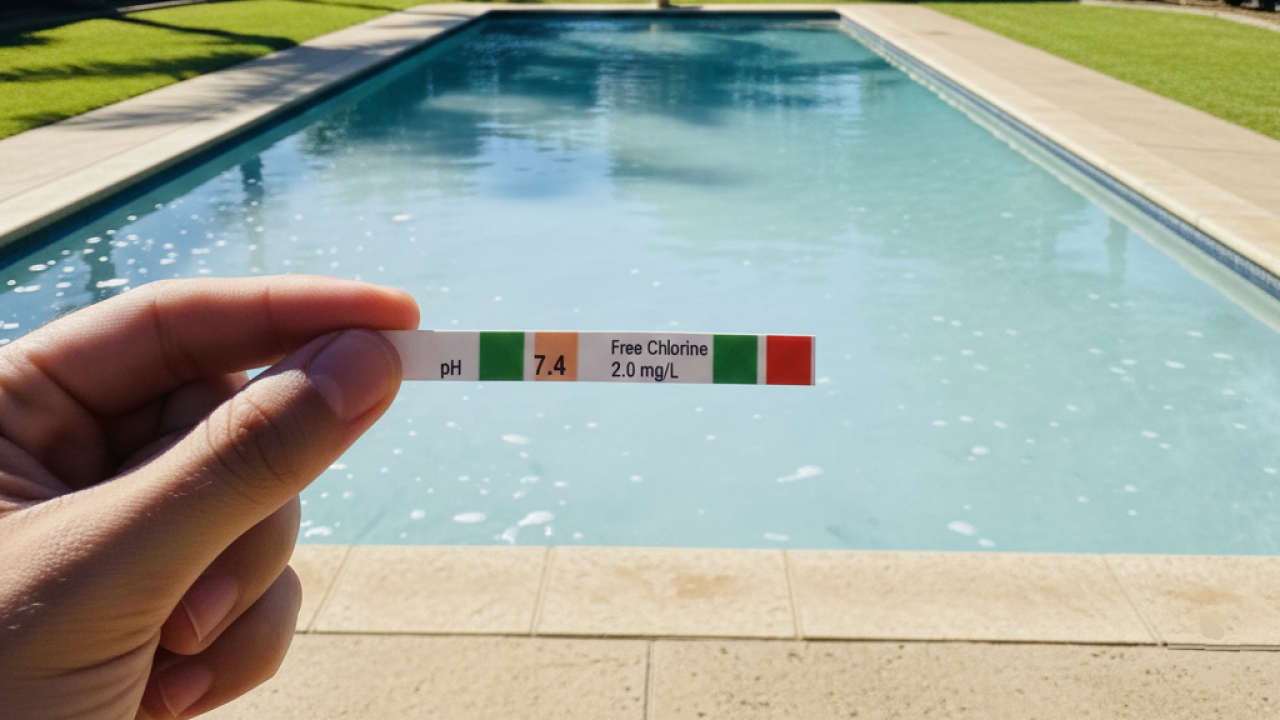Cloudy Pool Water but Chemicals Are Fine? 5 Hidden Causes & Fixes

It is the peak of the Australian summer, and you are ready for a dip. You dip your test strip, and the results look perfect: pH is sitting at a comfortable 7.4, and your free chlorine is steady at 2.0 mg/L. Yet, when you look at the water, it looks like milk.
This is a common frustration for many pool owners: cloudy pool water, but the chemicals are fine. It defies logic—if the chemistry is balanced, shouldn't the water be crystal clear?
The short answer is no. While chemical balance is crucial, it is only half the equation. In this guide, we will dive deep into the "invisible" culprits that standard test kits miss—from filtration flow rates to microscopic debris like bushfire ash. We will back this up with guidelines from NSW Health and industry standards to help you get your sparkle back.
Why Clarity Matters (More Than Just Looks)
Before we fix the problem, it is vital to understand the risk. A murky pool isn't just uninviting; it can be unsafe.
According to the NSW Health Public Swimming Pool and Spa Pool Advisory Document, effective circulation and filtration are essential for clear water. The department warns that "pools with poor clarity and turbidity are more likely to contain higher numbers of micro-organisms because turbidity reduces disinfection efficiency."
In simple terms: cloudy water acts as a shield for bacteria, protecting them from your chlorine. Even if your test says "Safe," the water clarity tells a different story.
Reason 1: Filtration System Issues (The Usual Suspect)
If your chemicals are balanced, the first place to look is your filter. Your pool water needs to circulate through the filter system enough times to remove fine particles.
The Turnover Rate
In the harsh Australian climate, organic load (sweat, sunscreen, pollen) is high.
- Sand Filters: If you haven't backwashed recently, the pressure might be too high to filter effectively.
- Cartridge Filters: A quick hose-down isn't always enough. Oils and sunscreens can clog the pores of the cartridge, which are invisible to the naked eye.
Pro Tip: During an Aussie summer (December–February), your pump should be running at least 8 to 10 hours a day. If you are using a variable speed pump, ensure the "low" setting is moving enough water to actually turn over the pool volume.
Reason 2: The "Invisible" Debris (Bushfire Ash & Pollen)
This is unique to our environment. Australia is prone to dust storms and, unfortunately, bushfires.
Even if there isn't a fire nearby, fine ash and dust can travel hundreds of kilometres in the wind. These particles are often too small (measured in microns) for a standard sand filter to catch. They pass right through the system and remain suspended in the water, causing that "milky" look.
- The Test: If you shine a torch into the pool at night and see millions of floating specs, you are dealing with micro-debris.
- The Fix: You may need a pool flocculant. This chemical binds tiny particles together so they sink to the floor. Once settled, you can vacuum them to waste.
For daily maintenance of fine debris, an automatic pool cleaner is designed with ultra-fine filtration capabilities, scrubbing the floor and walls to prevent this dust from settling permanently.

Reason 3: High Calcium Hardness or TDS
Most standard 4-in-1 test kits check pH, Chlorine, and Alkalinity. They often miss Calcium Hardness and Total Dissolved Solids (TDS).
If your pool water is cloudy but chemicals are fine, your water might be "hard" or "old."
The Saturation Point
According to SPASA Australia (Swimming Pool & Spa Association), the ideal Calcium Hardness range is 200–400 mg/L.
- If Calcium is too high (>400 mg/L), the water becomes saturated. Even a slight increase in temperature (common in summer) can cause the calcium to precipitate out of solution, turning the water cloudy.
- TDS: If you haven't drained and refilled your pool in 3-4 years, the water may simply be "tired," full of dissolved by-products that prevent clarity.
Table: The "Invisible" Water Balance Factors
| Parameter | Ideal Range (Aus Standard) | Effect of High Levels |
|---|---|---|
| Calcium Hardness | 200 – 400 mg/L | Scale formation, cloudy "milky" water |
| TDS (Total Dissolved Solids) | < 1,500 mg/L above fill water | Dull water, chemicals become ineffective |
| Cyanuric Acid (Stabiliser) | 30 – 50 mg/L | Chlorine lock (cloudy water despite high chlorine) |
| Phosphates | < 0.2 mg/L (or 200 ppb) | Food for algae, leads to murky green/grey water |
Reason 4: Early Stage Algae (The Green Ghost)
Sometimes, cloudiness is just the precursor to an algae bloom. This is known as the "pre-algae" stage.
Microscopic algae spores can float in the water before they turn green. They consume your chlorine rapidly. If you notice your chlorine levels dropping faster than usual (e.g., you add chlorine in the morning, and it's gone by the afternoon), you likely have nascent algae.
The Solution: Shock the pool (Superchlorinate) to raise the Free Chlorine level to 10 mg/L or higher to kill the spores before they bloom.
Reason 5: It Might Just Be Air (Aeration)
Before you spend money on chemicals, check if the cloudiness is actually... bubbles.
A suction leak in your pump system can pull air into the water lines. This creates micro-bubbles that make the water look white and cloudy.
The "Glass Test":
- Take a clear glass and fill it with pool water.
- Set it on a bench and wait 2 minutes.
- Result: If the water clears from the bottom up, it is air bubbles. You need to fix a leak in your pump or pipes. If the dirt settles to the bottom, it is debris.
Step-by-Step: How to Clear Up Your Pool
If you have determined it is not air bubbles, follow this protocol to restore clarity.
- Deep Clean the Filter:
- Sand Filter: Perform an extended backwash (2-3 minutes) followed by a rinse.
- Cartridge Filter: Soak the elements in a specialized filter cleaning solution to remove oils.
- Test and Balance (Again): Ensure pH is 7.2–7.6. High pH makes calcium cloudiness worse.
- Shock the Pool: Use a non-stabilised chlorine shock (Calcium Hypochlorite or Liquid Chlorine) to burn off organic compounds. Best done at dusk to prevent UV burn-off.
- Use a Clarifier or Flocculant:
- Clarifier: For mild cloudiness. It clumps particles so the filter can catch them.
- Flocculant: For heavy cloudiness. It sinks particles to the floor (Requires vacuuming to waste).
- Run the Pump 24/7: Keep the water moving until it clears.
- Deploy Your Robot: Use your robotic pool cleaner to handle the physical debris on the floor, ensuring nothing gets kicked back up into suspension.
FAQ
Q: Why is my pool cloudy after heavy rain?
A: Rainwater dilutes your chemicals and washes in contaminants (dirt, pollen, nitrogen). Even if pH is fine, the organic load creates cloudiness. Shock the pool and run the filter.
Q: Is it safe to swim in a cloudy pool?
A: Generally, no. If you cannot see the bottom of the main drain, it is a safety hazard (you cannot see a distressed swimmer). Also, as per NSW Health guidelines, cloudy water may harbor bacteria.
Q: How long does it take for a cloudy pool to clear?
A: With proper filtration and chemicals, it typically takes 2–3 days. If you use a flocculant, it can clear overnight, but requires manual vacuuming.
Conclusion
Dealing with cloudy pool water when chemicals are fine can be baffling, but it is usually a sign that your pool needs physical help, not just chemical adjustment. Whether it is fine Australian dust, a clogged filter, or high calcium levels, the solution lies in better filtration and circulation.
Keep your filter clean, monitor your TDS, and consider automating your cleaning routine with Aiper to ensure your pool is always ready for the next barbecue.
References
Greater Western Water. (n.d.). Water quality. https://www.gww.com.au/water-waste/your-water-supply/water-quality
Health Protection NSW. (2013, April). Public swimming pool and spa pool advisory document. NSW Government. https://www.health.nsw.gov.au/environment/Publications/swimming-pool-and-spa-advisory-doc.pdf
Swimming Pool & Spa Association of Australia (SPASA). (n.d.). Water balance. https://www.spasa.com.au/pool-and-spa-owners/faqs-tips-and-tricks/water-balance

